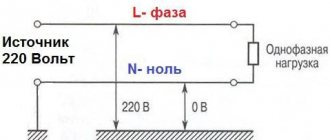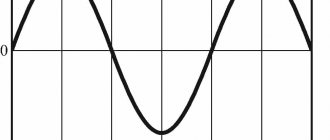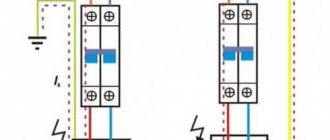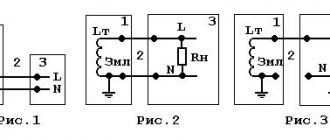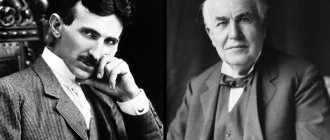This term has other meanings, see Zero.
- “There are two forms: zero
and
zero
.
In the terminological meaning (especially in indirect cases), the second is usually used, for example: equals zero, temperature is kept at zero
” [1]. - “...a derived adjective is usually formed from the form zero
, for example:
prime meridian, zero mark
”[1].
0
(
zero
,
zero
from the Latin
NULLus
- none [2]) - an integer that, when added to or subtracted from any number, does not change the latter [3], that is, gives a result equal to this latter; Multiplying any number by zero gives zero[4].
Kuznetsov’s large explanatory dictionary (2009)[5] lists both forms: zero, zero
- as equivalent.
However, from the examples given there it is clear that there is some difference: the form zero
is used mainly in the nominative case, there are also other indications of this rule (see sidebar).
Zero plays an extremely important role in mathematics and physics[6].
Content
- 1 Zero in mathematics 1.1 Basic properties of zero 1.1.1 Division by zero
- 1.1.2 Belonging to natural numbers
- 1.1.3 Meanings of individual functions
Zero in mathematics
Basic properties of zero
- 0 is an integer.
- Zero is an even number because dividing it by 2 produces an integer:
0/2 = 0.
- On the number line, 0 separates positive and negative numbers.
- Zero has no sign.
- Any number does not change when added to zero[2]:
a + 0 = 0 + a = a.
- When you subtract zero from any number, you get the same number:
a - 0 = a.
- Multiplying any number by zero gives zero[2]:
a \cdot 0 = 0 \cdot a = 0.
- When zero is divided by any non-zero number, the result is zero:
0/a = 0 for a\neq 0.
Division by zero
- Division by zero is impossible in any field or ring, including the fields of real and complex numbers.
In fact, if we denote \frac{a}{0} = b, then by the definition of division it should formally be b \cdot 0 = a, while the expression b \cdot 0, for any b, is equal to zero. In other words, there is no inverse element for zero in any field.
- Division by zero of a non-zero complex number is possible on the extended complex plane, its result is a point at infinity.
Belonging to natural numbers
There are two approaches to defining natural numbers - some authors include zero among natural numbers[7], others do not. In Russian school mathematics curricula, it is not customary to classify zero as a natural number, although this complicates some formulations (for example, it is necessary to distinguish between division with a remainder and division with a remainder). As a compromise, sources sometimes consider the “extended natural series”, including zero[8].
Values of individual functions
- The result of raising any number (except zero) to the zero power is equal to one: a^0 = 1. The expression 0^0 (zero to the zero power) is considered to be meaningless[9][10][11], that is, undefined.
This is due to the fact that the function of two variables x^y at the point \{0,0\} has an irremovable discontinuity. In fact, along the positive direction of the X axis, where y=0, it is equal to one, and along the positive direction of the Y axis, where x=0, it is equal to zero.
- The factorial of zero, by convention, is taken equal to one: 0! = 1.
Generalizations (zero in general algebra)
An analogue of zero can exist in any set on which the addition operation is defined; in general algebra such an element is sometimes called a neutral element
, sometimes -
additive zero
, most often -
zero relative to addition
.
Examples of such an element are the zero vector and the zero matrix. the multiplicative unit
, or
a unit relative to multiplication
can be considered as an analogue of zero .)
Algebraic structures equipped with both addition and multiplication can also contain an analogue of zero. The zero element contains any ring and its special cases - body and field. For example, a square zero matrix of size n\times n is the zero element of the ring of square matrices M_n(R). The polynomial ring also has a zero element - a polynomial with zero coefficients, or a zero polynomial
, p(x)\equiv 0.
Zero in mathematical analysis
- When calculating the limit of the ratio (a/b), where a \rightarrow 0 and b \rightarrow 0, a situation arises when direct substitution gives the expression (0/0), the value of which is undefined. In the process of revealing uncertainties, seven such situations are possible, and in four of them there is formally a zero: \left ( \frac{0}{0} \right ), (0^0), (\infty^0), (0\cdot \infty).
- A very specific situation is also possible when a one-sided (right or left) limit of an infinitesimal quantity is considered:
- Right limit: \lim_{x \to +0} \frac{1}{x}=\left( \frac{1}{0} \right)=+\infty _ or _ \left ( \frac{1} {x} \right ) \xrightarrow{} +\infty.
- Left limit: \lim_{x \to -0} \frac{1}{x}=\left( \frac{1}{0} \right)=-\infty _ or _ \left ( \frac{1} {x} \right ) \xrightarrow{} -\infty.
Zero in geometry
- A point can be considered as a zero-dimensional object.
- A point in the plane with one zero coordinate lies on the corresponding coordinate axis. Both zero coordinates define a point called the origin.
- A point in three-dimensional space with one zero coordinate lies on the corresponding coordinate plane. A point in three-dimensional space is again called the origin of coordinates if all its coordinates are zero.
- Similar statements are true for space of any dimension.
- On a circle, the 0° and 360° locations are the same.
Zero - the beginning of time
It is necessary to count years and times, otherwise people would not understand what happened first and what then...
The beginning of all time... Where is it? If this beginning is the moment of the emergence of the Universe, then scientists are still arguing when this happened... If it is the time of the emergence of life on Earth, then it is also difficult to decide...
Then people agreed on a conditional beginning of time, tying it to a specific event. As you may have guessed, this event is the Nativity of Christ. It is from the Nativity of Christ that we count our time, we count down our time. We consider the Nativity of Christ to be the zero point on the time line. Everything that happened before the Nativity of Christ was before our era; and everything that happened later was in our era.
Each person has their own relationship with zero. But no one wants to have zero income, zero success, zero relationships and zero knowledge. You can improve your knowledge of mathematics by studying articles in the Fun Mathematics section.
However, zero is not always such a thing, if you remember that it is “zero” - three out of forty casino cells with the designation zero - that brings fabulous profits to the gambling business!
What do you know about zero? Share with us.
Author: Svetlana Kaminskaya (Kamlan user)
We also recommend reading:
- Storytelling
- Is it possible to count in your head and remember, like Daniel Tammet?
- Feynman's self-learning method
- Unit economics: examples, calculations, formulas
- Productivity Techniques
- Continue the number line
- Number search problem
- Ten Entrepreneurial Misconceptions According to Guy Kawasaki
- How to teach a child to count quickly in his head
- Mnemonics: numbers
- Zero. This is the important Nothing. (Continuation)
Key words:1Cognitive science
History of the use of zero
Babylonian mathematicians used a special cuneiform symbol for sexagesimal zero starting around 300 BC. e., and their Sumerian teachers probably did this even earlier. Although there is no 0 in their number system, Egyptian mathematicians already from the Middle Kingdom (beginning of the 2nd millennium BC) used the hieroglyph nfr (“beautiful”) to denote zero.
Original zero codes were used even before our era by the ancient Mayans and their neighbors in Central America (the ancient Mayans designated zero with a stylized image of a shell).
In Ancient Greece, the number 0 was not known. In the astronomical tables of Claudius Ptolemy, empty cells were designated by the symbol ο (the letter omicron, from the ancient Greek οὐδέν - nothing
); it is possible that this designation influenced the appearance of zero, but most historians acknowledge that the decimal zero was invented by Indian mathematicians. Without zero, the decimal positional notation of numbers, invented in India, would not have been possible. The first zero code was found in an Indian record from 876 AD; it looks like a familiar circle.
In Europe, for a long time, 0 was considered a conventional symbol and was not recognized as a number; even in the 17th century Wallis wrote: “Zero is not a number.” In arithmetic works, a negative number was interpreted as a debt, and zero as a situation of complete ruin. The works of Leonhard Euler especially contributed to its complete equalization in rights with other numbers.
The disadvantages of non-positional counting systems are their cumbersomeness and impracticality. For example, imagine writing two numbers 3000 and 2998. These numbers differ only by two units and in our usual Arabic notation these numbers will take the same place in the notebook, but let's see how they will look in the non-positional ancient Egyptian notation:
How did people solve this problem? To answer this question, let's move to ancient Babylon. Here one very significant event for mathematics happened - the positional counting system was opened. Babylonian mathematicians reasoned that to represent all numbers they would only need two symbols: the first, a standing wedge to represent units, and the second, a lying wedge to represent tens (they used the sexagesimal number system, below we will explain how this works). Let's figure out how they came up with this simple idea. To begin with, let us remember that when people counted, they tried to group objects: tens of tens is a hundred, tens of hundreds are a thousand, and so on. It was convenient for Babylonian mathematicians to group objects into 12 groups, but into 5 groups (remember about the number of fingers?), so the sexagesimal number system appeared (12 x 5 = 60). Why did they choose 60 as the basis for counting, instead of the seemingly convenient 10? By the way, we also use this system when measuring time (60 minutes is 1 hour and so on). Because of convenience, because 60 can be decomposed into more factors (2*2*3*5 = 60) than 10 (2*5 = 10).
So what did Babylonian numbers look like?
How, for example, did the Babylonians write down the numbers 62? Let's try to figure it out. The number 62 looks like . Let's look at the table, it shows that this entry has the following meaning for us - “1 2”. How so? After all, we meant the number 62. Take your time, everything is correct, but we should pay attention to the space between these numbers and remember that, depending on the position, the numbers can carry additional meaning. So, the leftmost “unit” shows the number of complete groups, in our case this means that there are 60 units in the number, followed by 2. As a result, it means 1x 60 + 2 = 62. It’s simple. But how can you avoid accidentally confusing the number (number 2) with (number 61)? Visually, they are not very different from each other (not everyone can see the space). At first, the Babylonians tolerated this problem and had to guess from the context of the problem what number they were talking about. But in the end it was necessary to replace this emptiness with a certain symbol, and so zero appeared.
Zero in other areas of science and technology
Zero is often used as a reference point. Examples are very numerous.
- Zero appears in many branches of physics: When measuring the volume of sound in the background, the threshold of audibility is taken as 0.
- The minimum possible energy level of a quantum mechanical system is called zero-point energy.
- The known absolute zero temperature is 0 on the Kelvin scale. In everyday life, however, other temperature scales are more often used. In particular, on the Celsius scale the freezing point of water is arbitrarily taken to be 0.
Zero in Mayan history
The Mayan Indians actively used the base-20 system in their writings. Their understanding of the world, religious beliefs and scientific knowledge were very deep, but in many ways alien and incomprehensible to modern people. However, scientists are still surprised by how accurate the calculations made by the Mayans several thousand years ago were.
It is noteworthy that they put zero at the beginning of the number series and even gave it the name of one of the days. Moreover, the number in their understanding did not mean emptiness; rather, its pronunciation was similar to the word “beginning.” Subconsciously, the Mayans understood how deep the understanding of this number was. But still they did not use it in calculations. Surprisingly, zero, which plays an important role in calendars and other handwritten texts, was not at all perceived as an independent number.
Zero in language and culture
- “ We honor everyone with zeros, and ourselves with ones
” - a quote from Pushkin’s poem “Eugene Onegin”[12] (chapter 2, stanza 14), used ironically when talking about someone’s inflated self-esteem and disdainful attitude towards others[13] . - At zero
- the absence of something.
For example, “ finances are at zero
” (colloquial use)[14]. - Zero
in a figurative sense means an insignificant, insignificant person, for example: “
He is an absolute zero
”[14]. - The expression zero without a stick
, when talking about a person, means that he has no influence, meaning (colloquial and humorous use)[14], as well as an incompetent, stupid person[15]. - Zero attention
- lack of attention[14]. - The expression zero-zero
, used after indicating the hour of the day, means: exactly at such and such an hour, without minutes [14]. In sports, the same expression can denote a draw outcome of a game or competition[16]. - to start from scratch
- to start from scratch (colloquial use)[14] or start something without prior preparation[16]. - Cutting your hair to zero
is the same as cutting your hair bald[16].
Feature 0 in numerology
The number 0 in numerology contains a sacred meaning about the spiritual beginning of its material nature. Zero is an anti-number and ranks first in the number series. It hides the great potential of the entire system of creations.
The English occultist and tarot reader A. Crowley described 0 with a mathematical numerological formula: 0=2, where 0 (Nuit or not I) means universal expansion and 2 (Hadit) - universal compression.
In numerology, the number 0 is the beginning of everything, the spiritual root cause of existence.
The sacred meaning of zero is explained by its shape. She is equated to the divine world. The round shape means infinity. It has neither beginning nor end.
Positive traits of number 0
Positive zero value:
- the beginning of everything;
- all-consuming energy;
- harmonious relationships;
- laws of the universe.
In numerological characteristics, the number means hidden possibilities and strengths that are inherent in a person from birth. To reveal them, you need to understand the signs of fate and do everything to achieve your goal.
The meaning of the number zero in the date of birth is reserve forces from past lives and reincarnations. Man knows nothing about their existence. For these qualities to change life, a person needs to make a choice between good and evil.
The repeated number 0 in the date of birth means poor development of the spiritual life of the individual. In numerology, this number is considered as a journey into your own spiritual world. If we neglect this possibility, the reserve power inherent in a person will turn into evil and bring harm not only to him, but also to his environment.
Negative traits of number 0
Negative qualities of zero:
- emptiness;
- death;
- secrets;
- lack of consciousness;
- chaos.
Human desires regulate the secret forces of zero. They create or destroy energy depending on the direction.
In numerology, death has a metaphysical meaning. Just like in Tarot cards, death signifies the completion of the life cycle. It requires renewal of consciousness, soul, body and new transformations.
Notes
- ↑ 1 2 D. E. Rosenthal
. [www.evartist.narod.ru/text1/31.htm Reference book on spelling, pronunciation, literary editing. Chapter X. Spelling of numerals.] M.: CheRo, 1999. - ↑ 123
Encyclopedic Dictionary of Young Mathematicians, 1985. - [enc-dic.com/ozhegov/Nol-18823/ Zero – Ozhegov’s Explanatory Dictionary – Encyclopedias & Dictionaries]
- [dic.academic.ru/dic.nsf/enc3p/215950 ZERO] // Big Encyclopedic Dictionary. 2000.
- Great Dictionary of Russian language. Ch. ed. S. A. Kuznetsov. First edition: St. Petersburg: Norint, 1998.
The most important number is zero.
It was a brilliant idea to make something out of nothing, give it a name and invent a symbol for it. “It’s like re-chasing Nirvana into a dynamo,” says Halstead. — Van der Waerden B.L.Awakening Science. Mathematics of ancient Egypt, Babylon and Greece. - M.: Fizmatlit, 1959. - P. 77.
- [books.google.com/books?id=7xArILpcndYC The historical roots of elementary mathematics]. - Courier Dover Publications, 1976. - P. 254–255. — ISBN 0-486-13968-9., [books.google.com/books?id=7xArILpcndYC&pg=PA255 Extract of pages 254–255]
- Potapov M.K., Aleksandrov V.V., Pasichenko P.I.
Algebra and analysis of elementary functions. - M.: Nauka, 1981. - P. 9. - 560 p. - [math-prosto.ru/?page=pages/stepeni/stepeni1.php What is a power of a number] // School mathematics, online resource.
- [scienceland.info/algebra7/degree-zero Why does a number to the power of 0 equal 1?] // Scienceland, online resource.
- [enc-dic.com/enc_sovet/Stepennaja-funkcija-85229.html Power function] // Great Soviet Encyclopedia. - M.: Soviet Encyclopedia 1969-1978.
- [dic.academic.ru/dic.nsf/aphorism/3137/Winged Winged Phrases] // Consolidated encyclopedia of aphorisms. Academician. 2011.
- [dic.academic.ru/dic.nsf/dic_wingwords/1581/We We honor everyone with zeros, / And ourselves with ones] // Encyclopedic Dictionary of Wingwords and Expressions. — M.: “Lockeed-Press”. Vadim Serov. 2003.
- ↑ 123456
[dic.academic.ru/dic.nsf/dic_fwords/46578/zero zero] // Explanatory dictionary of foreign words by L. P. Krysin. - M: Russian language, 1998. - [russian_argo.academic.ru/7728/zero zero] // Dictionary of Russian argot. — GRAMOTA.RU. V. S. Elistratov. 2002.
- ↑ 123
[feb-web.ru/feb/mas/mas-abc/14/ma250721.htm ZERO and ZERO] // Dictionary of the Russian language: In 4 volumes / RAS, Institute of Linguistics. research; Ed. A. P. Evgenieva. — 4th ed., erased. - M.: Rus. language; Polygraph resources, 1999.
Literature
- Charles Safe.
Zero. Biography of a Dangerous Idea = Zero: The Biography of a Dangerous Idea. - Neoclassic, AST, 2014. - 288 p. — ISBN 978-5-17-083294-1. - Zero // Encyclopedic Dictionary of a Young Mathematician / Comp. A. P. Savin. - M.: Pedagogy, 1985. - P. 219. - 352 p.
- Lamberto Garcia del Cid.
The first natural numbers and their meaning → 0 is an ambiguous number // Wonderful numbers. Zero, 666 and other beasts. - DeAgostini, 2014. - T. 21. - P. 14-15. — 159 p. - (World of Mathematics). — ISBN 978-5-9774-0716-8. - David Wells.
0 // The Penguin Dictionary of Curious and Interesting Numbers. - Penguin Books, 1986. - pp. 23-26. — 229 p. — ISBN 0-14-008029-5.
Links
Wiktionary has an article «»
Wiktionary has an entry for "zero"
Wiktionary has an entry for "null"
- ) • Periods • Computable • Arithmetic |heading2= Real numbers
|list2=Real (\scriptstyle\mathbb{R}) • Complex (\scriptstyle\mathbb{C}) • Quaternions (\scriptstyle\mathbb{H}) • Cayley numbers (octaves, octonions) (\scriptstyle\mathbb{O }) • Cedenions (\scriptstyle\mathbb{S}) • Alternions • Dual • Hypercomplex • Superreal • Hypermaterial • Surreal[en]|heading3= Extension Tools
|list3=Cayley-Dixon procedure • Frobenius theorem • Hurwitz theorem
|heading4= Hierarchy of numbers |list4=
1,\;2,\;\ldots Integers |heading5= Others
|list5=Cardinal numbers • Ordinal numbers (transfinite, ordinal) • p-adic • Supernatural numbers|heading6= See also
|list6=Double numbers • Irrational numbers • Transcendental numbers • Number ray • Biquaternion
}}
-1,\;0,\;1,\;\ldots Whole numbers -1,\;1,\;\frac{1}{2},\;\;0{,}12,\frac{2}{3},\;\ldots Rational numbers -1,\;1,\;\;0{,}12,\frac{1}{2},\;\pi,\;\sqrt{2},\;\ldots Real numbers -1,\;\frac{1}{2},\;0{,}12,\;\pi,\;3i+2,\;e^{i\pi/3},\;\ldots Complex numbers 1,\;i,\;j,\;k,\;2i + \pi j-\frac{1}{2}k,\;\dots Quaternions 1,\;i,\;j,\;k,\;l,\;m,\;n,\;o,\;2 – 5l + \frac{\pi}{3}m,\;\ dots Octonions 1,\;e_1,\;e_2,\;\dots,\;e_{15},\;7e_2 + \frac{2}{5}e_7 — \frac{1}{3}e_{15},\ ;\dots Cedenions : Incorrect or missing image To improve this article it is desirable: - Find and arrange in the form of footnotes links to independent authoritative sources that confirm what is written. K: Wikipedia: Articles without sources (type: not specified)

